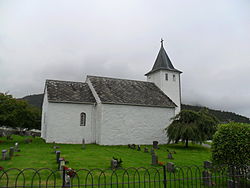쿠라모토-시바신스키 방정식
Kuramoto–Sivashinsky equation수학에서 쿠라모토-시바신스키 방정식(KS 방정식 또는 불꽃 방정식이라고도 함)은 4차 비선형 부분 미분 방정식이다.1970년대 후반 층화 불꽃 전선에서 확산 불활성화를 모형화하기 위해 이 방정식을 도출한 쿠라모토 요시키와 그레고리 시바신스키의 이름을 따서 지은 것이다.[1][2][3]쿠라모토-시바신스키 방정식은 무질서한 행동으로 알려져 있다.[4][5]
정의
쿠라모토-시바신스키 방정식의 1d 버전은
대체 형태는
에 대해 차별화하고 = x 를 대체하여 얻음 fluid dynamics 애플리케이션에서 사용되는 형식이다.[6]
쿠라모토-시바신스키 방정식도 보다 높은 차원으로 일반화할 수 있다.공간적으로 주기적인 영역에서, 한 가지 가능성은
여기서 은(는) 라플라스 , 2 {\ \Delta}}은 생체해효 연산자다.
특성.
The Cauchy problem for the 1d Kuramoto–Sivashinsky equation is well-posed in the sense of Hadamard—that is, for given initial data , there exists a unique solution that depends continuously on the initial data.[7]
1d 쿠라모토-시바신스키 방정식은 갈릴레이의 침입 즉, , t) 이(가) 이라면 - , ) - 도 마찬가지인데 서 c 은 임의 상수이다.[8]물리적으로 이(가) 속도이기 때문에 이 변수의 변화는 일정한 상대 c{\을(를) 가지고 움직이는 프레임으로의 변환을 기술하고 있다 주기적인 영역에서 방정식은 ( x, ) 이 해결책이라면- (- x,) 도 해결책이다.[8]
해결 방법
쿠라모토-시바신스키 방정식의 해법은 풍부한 역동적 특성을 가지고 있다.[8][9][10]주기적 영역 0에서 고려되는역학 관계는 도메인 크기 이 증가하면서 일련의 분기를 거치게 되며, 이는 혼란스러운 동작의 시작으로 절정에 이른다. 의 값에 따라 용액에는 평형, 상대 평형 및 이동파가 포함될 수 있으며, 이 모든 것은 으로L {\ L이 증가함에 따라 동적으로 불안정해진다특히 혼돈으로의 이행은 기간동안의 분기에 의해 폭포처럼 일어난다.[10]
적용들
쿠라모토-시바신스키 방정식의 적용은 불꽃 전파와 반응-확산 시스템의 원래 맥락을 벗어난다.이러한 추가 용도는 파이프와 인터페이스, 플라스마, 화학 반응 역학 및 이온 분사 표면의 모델을 포함한다.[6][11]
참고 항목
참조
- ^ Kuramoto, Yoshiki (1978). "Diffusion-Induced Chaos in Reaction Systems". Progress of Theoretical Physics Supplement. 64: 346–367. doi:10.1143/PTPS.64.346. ISSN 0375-9687.
- ^ Sivashinsky, G.I. (1977). "Nonlinear analysis of hydrodynamic instability in laminar flames—I. Derivation of basic equations". Acta Astronautica. 4 (11–12): 1177–1206. doi:10.1016/0094-5765(77)90096-0. ISSN 0094-5765.
- ^ Sivashinsky, G. I. (1980). "On Flame Propagation Under Conditions of Stoichiometry". SIAM Journal on Applied Mathematics. 39 (1): 67–82. doi:10.1137/0139007. ISSN 0036-1399.
- ^ Pathak, Jaideep; Hunt, Brian; Girvan, Michelle; Lu, Zhixin; Ott, Edward (2018). "Model-Free Prediction of Large Spatiotemporally Chaotic Systems from Data: A Reservoir Computing Approach". Physical Review Letters. 120 (2): 024102. doi:10.1103/PhysRevLett.120.024102. ISSN 0031-9007.
- ^ Vlachas, P.R.; Pathak, J.; Hunt, B.R.; Sapsis, T.P.; Girvan, M.; Ott, E.; Koumoutsakos, P. (2020-03-21). "Backpropagation algorithms and Reservoir Computing in Recurrent Neural Networks for the forecasting of complex spatiotemporal dynamics". Neural Networks. 126: 191–217. doi:10.1016/j.neunet.2020.02.016. ISSN 0893-6080.
- ^ a b Kalogirou, A.; Keaveny, E. E.; Papageorgiou, D. T. (2015). "An in-depth numerical study of the two-dimensional Kuramoto–Sivashinsky equation". Proceedings of the Royal Society A: Mathematical, Physical and Engineering Sciences. 471 (2179): 20140932. doi:10.1098/rspa.2014.0932. ISSN 1364-5021. PMC 4528647.
- ^ Tadmor, Eitan (1986). "The Well-Posedness of the Kuramoto–Sivashinsky Equation". SIAM Journal on Mathematical Analysis. 17 (4): 884–893. doi:10.1137/0517063. ISSN 0036-1410.
- ^ a b c Cvitanović, Predrag; Davidchack, Ruslan L.; Siminos, Evangelos (2010). "On the State Space Geometry of the Kuramoto–Sivashinsky Flow in a Periodic Domain". SIAM Journal on Applied Dynamical Systems. 9 (1): 1–33. doi:10.1137/070705623. ISSN 1536-0040.
- ^ Michelson, Daniel (1986). "Steady solutions of the Kuramoto-Sivashinsky equation". Physica D: Nonlinear Phenomena. 19 (1): 89–111. doi:10.1016/0167-2789(86)90055-2. ISSN 0167-2789.
- ^ a b Papageorgiou, D.T.; Smyrlis, Y.S. (1991), "The route to chaos for the Kuramoto-Sivashinsky equation", Theoret. Comput. Fluid Dynamics, 3: 15–42, doi:10.1007/BF00271514, ISSN 1432-2250
- ^ Cuerno, Rodolfo; Barabási, Albert-László (1995). "Dynamic Scaling of Ion-Sputtered Surfaces". Physical Review Letters. 74 (23): 4746–4749. arXiv:cond-mat/9411083. doi:10.1103/PhysRevLett.74.4746. ISSN 0031-9007.



 대해 차별화하고
대해 차별화하고 

 (는)
(는)  생체해효
생체해효 



 임의 상수이다.
임의 상수이다.


 증가하면서 일련의
증가하면서 일련의 

